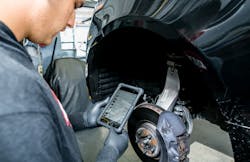According to Jeremy O’Neal, president of AdvisorFix and owner of Freedom Auto Repair in Hesperia, Calif., gone are the days where shops write out vehicle inspections on paper. Since shop owners are already digitizing other aspects of their businesses, incorporating digital inspection software comes as a natural next step.
O’Neal, who has won awards and received national recognition for his sales and service advisor training, has owned Freedom Auto Repair for a little over a year and one of the first things he did upon opening the shop was add digital inspection software. By migrating to digital inspections, he’s seen immediate improvements in KPIs such as efficiency, average repair order and customer retention.
Echoing O’Neal’s push for more shops to adopt digital inspection software are John Cooper and Nate Winston, owners of East Coast Performance (ECP) Auto Repair & Service in Cuyahoga Falls, Ohio. Cooper’s shop is a small operation, generating roughly $512,000 in annual revenue, and he was looking for ways to make his team more efficient. That’s why he decided to add digital inspection software a year ago, a move from which he’s already witnessing the immediate impact.
“Our profit margin went up 35 percent overnight,” Cooper says. “Turnaround time is so much quicker. Our AROs are 30 percent higher than what they were by the end of the year. It’s amazing, almost like it’s too good to be true. But this didn’t happen overnight.”
Ratchet+Wrench spoke with O’Neal and Cooper to learn what it takes to successfully implement digital inspections into a shop’s processes.
Getting Educated and Trained
As a shop owner, you need to figure out which technology will work best for your shop and get some training on it, O’Neal says. This could mean speaking with a consultant and scheduling a demo in your shop, during a 20 Group meeting or going to a trade association’s event and speaking to vendors.
Educating your staff is the next step. It may be an uphill battle, O’Neal says, as some technicians might be deadset in the old ways of paper processes. However, demonstrations and training will ease their concerns. Have a consultant come in and provide your staff with an in-depth tutorial of the software. The training you provide to your staff needs to be easy to explain and understand, O’Neal says, as a technician or service advisor will then have to explain it to a customer, who has no prior knowledge of industry terms or processes. For example, if the digital inspection software works best on a tablet, get your staff comfortable with navigating the user interface. If a customer is confused on where to get information on his or her vehicle, your staff will know exactly where to find the answer.
Once vehicle inspections become digitized in your shop, O’Neal notes, take time to make your way around the shop and commend staff for following the correct process. Provide a form of constant reinforcement, so this process becomes a habit and integrates with ease.
Building Trust in the Technology
Both Cooper and O’Neal agree: Once you’ve educated your staff on digital inspections and the software your shop uses, the next step is to engage your customers and foster trust in your system.
Look at digital inspections through the lens of a customer: How do they benefit from it?
For one, O’Neal asserts, digital inspections improve the lines of communication during the vehicle repair process. The customer can clearly see the condition of the vehicle and the software also provides visuals for additional items the customer was previously unaware may need attention. The customer can then work with the service advisor to prioritize repairs.
There are two essential aspects customers need to know about digital inspection software, says O’Neal: what it is and how to navigate it. Start off by having a service advisor give the customer a rundown, and explain that he or she can navigate the car’s inspection through pictures and the notes provided by the technician. The customer also needs to know that digitizing this process offers more honesty and engagement throughout the process.
The bottom line, O’Neal says, is that when the customer leaves your shop, they should be able to run through the interface themselves with little guidance. With the proper education, the user can navigate the interface and click through images and video of the vehicle and decide what services to add on. In most cases, customers can accept the estimate with the click of a button.
“We don’t peer pressure people into buying, but we let them know when the future things are coming up,” Cooper says. “When presenting a sale to customers on things they needed, a couple of times we’ve forgotten to check the cabin filter, and then the customer will look at the photos and just ask about the cabin filter: ‘Can you change that too?’”
That is why proper training for your staff is essential, he says. If the software is too difficult for staff to understand, then they won’t be able to explain it and transfer their knowledge to customers.
Communicating with the Customer
O’Neal notes that shops will only see 40 percent engagement—which refers to the number of customers using the software to track their vehicles’ repairs—if the shop doesn’t communicate with customers and explain the process to them.
Another vital aspect to making sure digital inspections are successful in your shop is to maintain an open dialogue with your customers about the repair process, Cooper notes. By getting techs in the habit of providing updates—either through pictures, video or documented notes—to the customer, you are building trust and easing any anxiety. Cooper’s technicians have made this a common practice as they go through the repair process.
“Our technicians can take pictures,” Cooper says. “Instead, before when brake pads were bad, I would have to go out and check personally and make sure we’re doing right by our customer. But now, they take pictures and I can see exactly how bad they are.”
Technicians at ECP Auto Repair & Service utilize the digital inspection software to add pictures and videos of trouble areas within the vehicle as they run through a vehicle inspection. After adding in images and video, the technician can go in and circle particular things within the picture to highlight a concern they have. The shop can then send text notifications and emails to provide updates or request action from the customer.
Within the vehicle inspection module, the technician can go through the different parts he checks during the vehicle inspection and use canned responses. For example, when checking fluid levels and colors, there are pre-filled out notes he can add, aside from his or her own recommendations, or different colors that indicate the condition of the part.
“If I need to ask a customer something, I shoot them a text. They respond pretty quickly and it shows up on my computer,” Cooper says.



